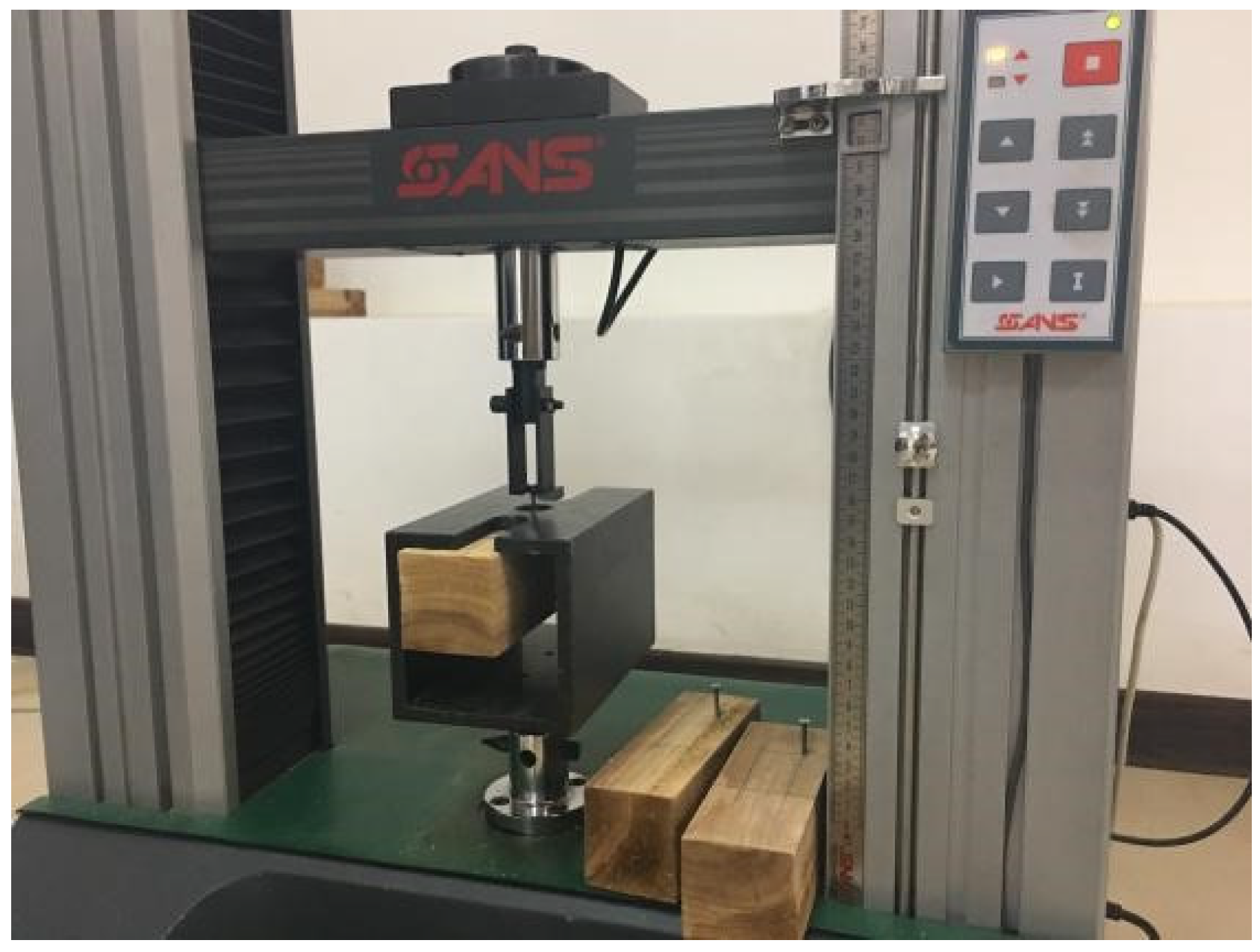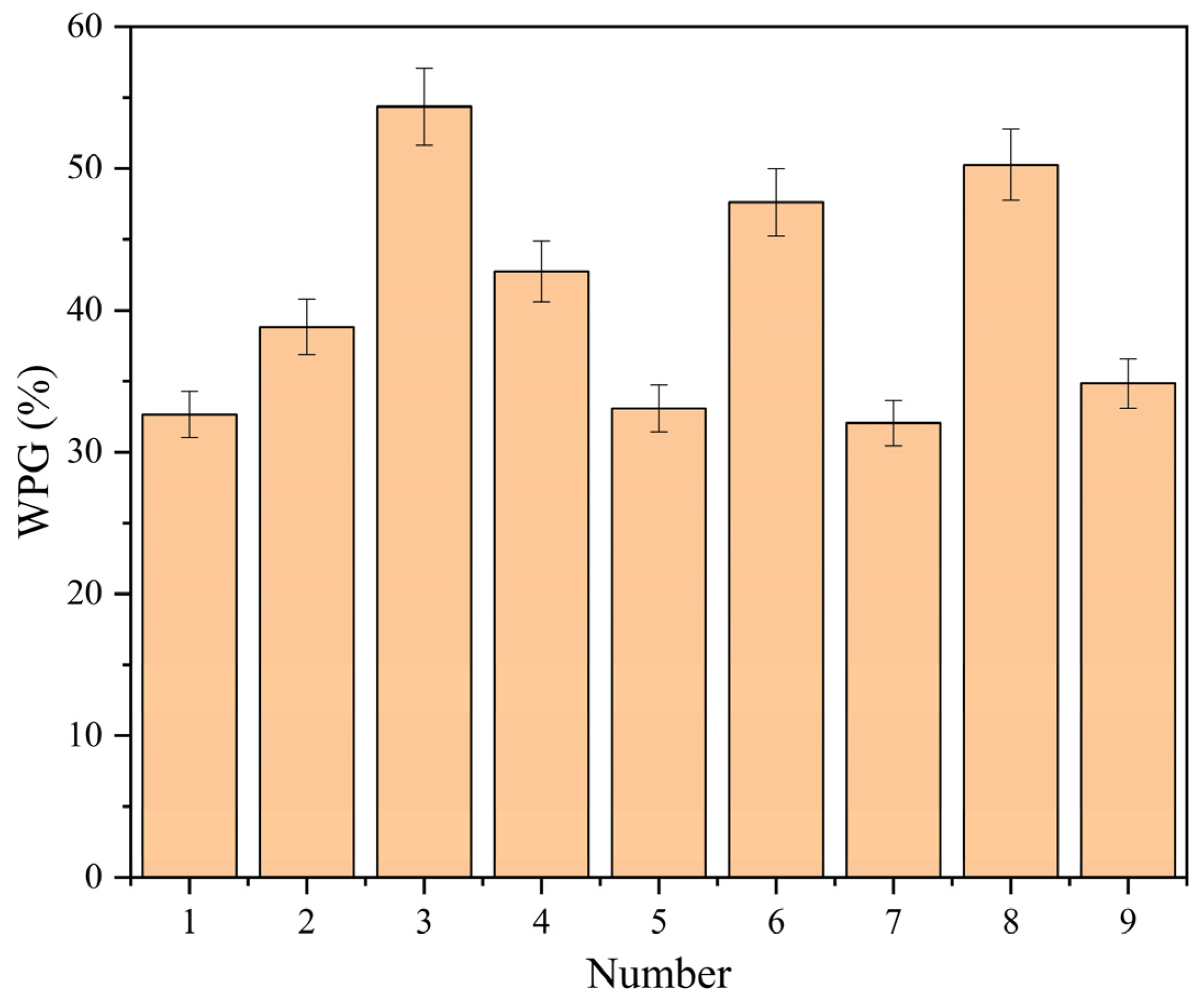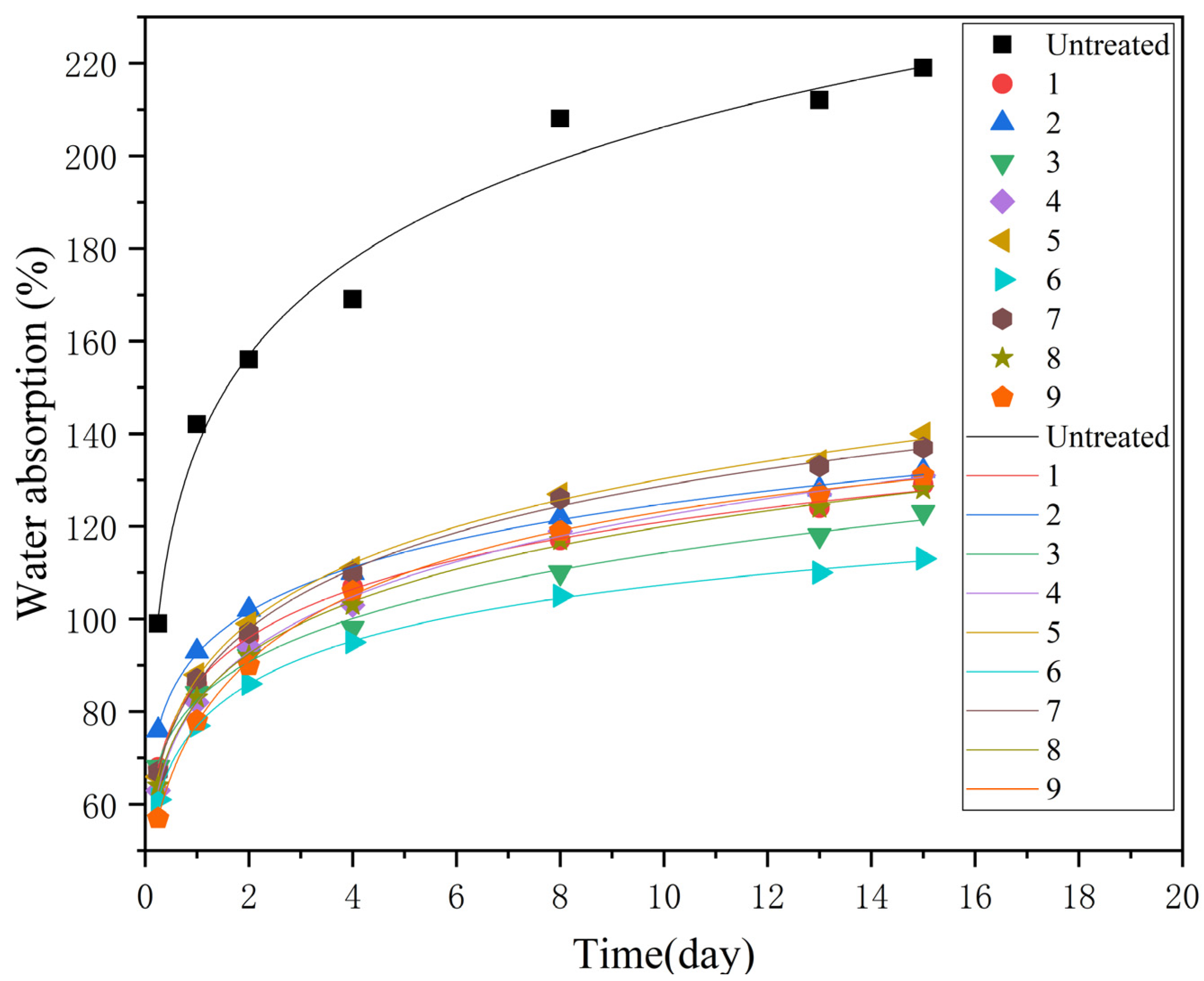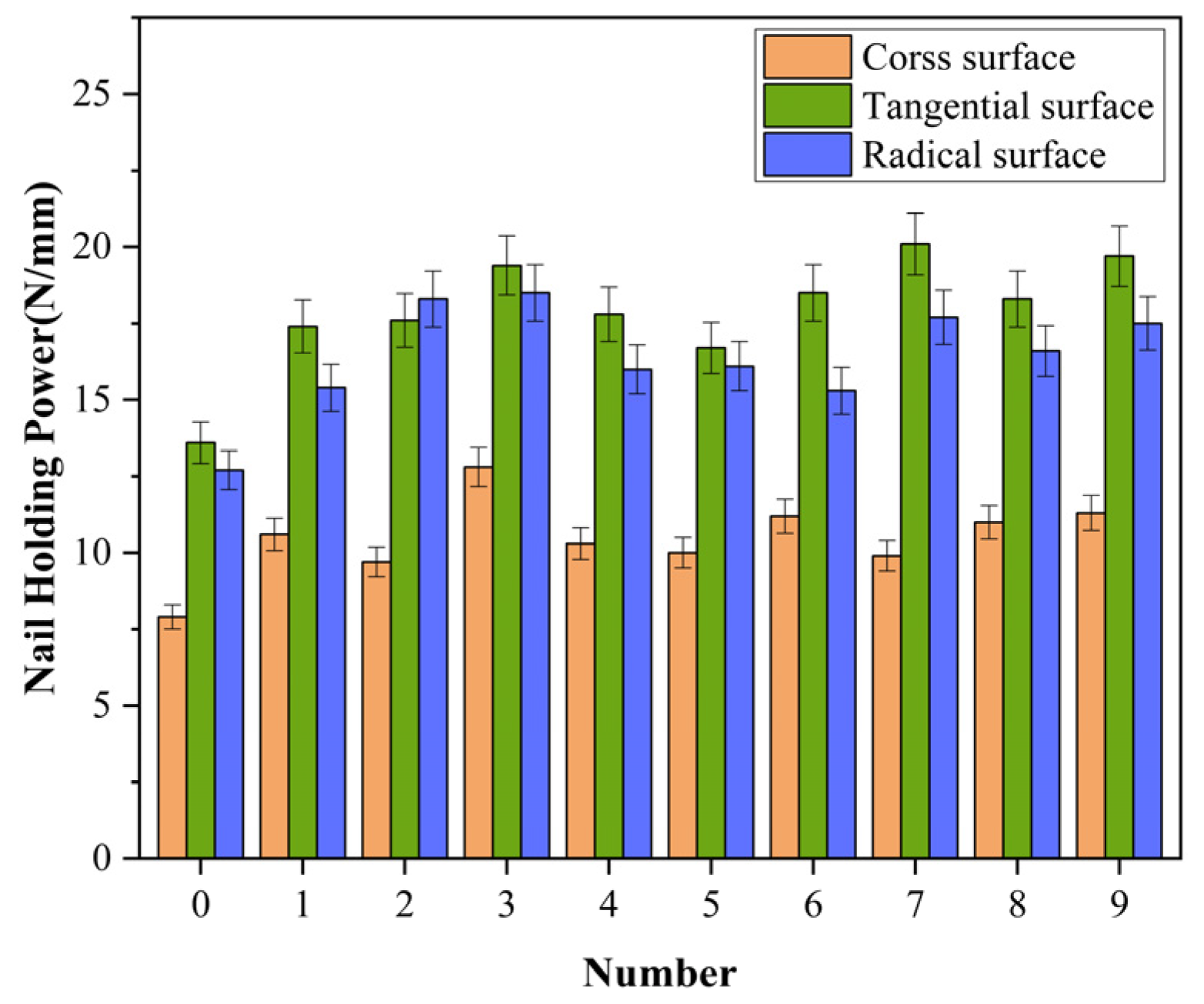3.1. Weight Percent Gain
The experimental data showed an increase in the weight of all the impregnated materials, which indicates that the silica sol impregnated and filled the samples’ internal voids (
Table 2). The silica sol mainly covered the inner surface of the samples’ cell walls at the beginning of impregnation. As the pressurization time increased, the samples’ cell cavities were filled with silica sol, and the amount of silica sol adhering to the cell wall decreased. A higher weight of samples indicates that more silica sol was deposited in the cells, and more cell lumens were full of silica sol [
25]. The difference in weight percent gain between the groups indicates that the impregnation process has an impact on the impregnation effect. The WPG of the third and eighth specimen groups exceeds 50% (
Figure 4), indicating that more silica sol was deposited in the cell lumen and more cell lumens were full [
12,
26]. Compared to Group 8, the pressurization time of Group 3 was longer, and the pressurization pressure was higher in both groups. It can be inferred that more silica sol entered the samples’ interior under high pressure and continued to be deposited as the pressurization time increased. The fourth group of samples did not show a high weight percent gain at the same pressurization pressure, probably due to the pre-vacuum pressure reduction. The lower pre-vacuum pressure caused the air not to be fully discharged, which prevented silica sol from impregnating and filling the intercellular space. There was a similar performance between the third and eighth groups. The two groups had different values of pre-vacuum pressure, which was slightly lower in Group 8, but the pre-vacuum time was extended accordingly, with less change in the effect on the final weight percent gain.
3.2. Water Absorption
The water absorption curves of the untreated and modified wood samples were plotted according to the measured data, as shown in
Figure 5. The water absorption rate was high during the first 24 h of soaking, and it progressively became flat as the soaking period was extended. There was much space to store water inside the thoroughly dried specimens. The water quickly encroached under the pressure difference between the inside and outside. The moisture increase in wood would gradually raise the osmotic pressure, slowing water from entering the wood. Meanwhile, the water absorption rate reduction is also due to the reduction in internal water storage space. Compared with the untreated fir wood, the impregnated fir wood’s water absorption rate was significantly lower. One of the explanations for the phenomenon was that after the impregnation treatment, the silica sol clusters filled part of the wood’s voids, blocking some water pathways and occupying water storage space. Thus, the water absorption rate was reduced [
27]. In addition, silica molecules bind to -OH in the wood matrix, thereby reducing the wood’s binding of moisture and decreasing water absorption [
28]. The water absorption curves of the modified materials were in proximity. However, it can still be discovered that the samples in the third, sixth, and eighth groups had lower water absorption rates due to more significant WPG and better impregnation. Such a difference also indicated that the impregnation process affects the material properties. The sixth group of specimens had a lower WPG and better hydrophobicity than the third group. It is possible that part -OH groups on silica sol in the Group 3 specimens absorbed water [
12]. Therefore, selecting appropriate process parameters is essential.
Based on the measured water absorption data of the untreated and modified specimens, the logarithmic function model about water absorption days and water absorption rate was established using regression analysis, as shown in
Table 3. The correlation index R
2 ranges from 0 to 1. As the value of R
2 gets closer to 1, it indicates that the measured value is closer to the regression value. Then, the regression equation has a better fit. The untreated and modified specimens’ correlation coefficients R
2 were between 0.9826 and 0.9985 (
Table 3), indicating that all ten logarithmic functions’ regression equations fitted well. Therefore, the ten logarithmic functions can describe the relationship between the water absorption days and the water absorption rate of all test specimens.
As shown in
Table 4, within 6 h, the untreated fir samples’ water absorption was close to 100%, while the treated samples were below 76% in all cases. Only one group of treated specimens had slightly more than 100% water absorption after 2 days. After 8 days, all treated specimens exceeded 100% water absorption, while untreated materials exceeded 200%. Overall, it was observed that the modified samples’ water absorption was significantly lower than untreated.
Table 4 and
Figure 5 show that all modified wood’s water absorption efficiency decreased. From the fitted curve, the number of days required for the samples to reach 100% water absorption was extrapolated. According to the data, it took 0.2683 days for untreated wood to reach 100% water absorption, while it took 1.6251~5.6817 days for modified wood. The modified wood took 6–21 times longer than the untreated wood to reach 100% water absorption. Moreover, Group 3, with better WPG, took the longest time to reach 100% water absorption, which can also be used to infer how modified wood behaves in long-term moisture absorption. The slopes of the fitted functions for the modified samples are all significantly lower than those of the untreated samples (
Table 3 and
Figure 5). The study indicated that the modified specimens’ water absorption was significantly reduced.
More specifically, range and variance analyses were performed on the modified wood to explore the correlation between process factors and water absorption.
Table 5 is the range analysis of the different days when the modified specimens reached 100% water absorption. Level means the different processing parameters for the four processing factors (i.e., the three levels of pre-vacuum treatment time are 10 min, 20 min, and 30 min). The difference between the maximum and minimum values of the experimental data at various levels is known as the range. A larger range value indicates that the factor has a better positive effect on performance.
The pre-vacuum pressure had the most significant effect on the modified wood’s water absorption in
Table 5. Moreover, the effects of pressurization time, pre-vacuum time, and pressurization pressure decreased in order. With a lower water absorption rate, wood products are more durable and have better dimensional stability. Modified wood had the best hydrophobicity and took the longest to reach 100% water absorption when the pre-vacuum time was 10 min, the pre-vacuum pressure was −0.06 MPa, the pressurization time was 3 h, and the pressurization pressure was 0.8 MPa.
Table 6 shows the variance analysis and significance test for the effect of variable factors on modified wood’s water absorption. The significance of all four factors was more than 0.05, indicating that none significantly impacted the water absorption of the modified specimens.
3.3. Nail-Holding Power
Figure 6 and
Table 7 show the analysis of the nail-holding power for the untreated and modified specimens.
As shown in
Table 7, cross surfaces’ nail-holding power of untreated fir wood was about 7.9 N/mm and increased by 23% to 62% about modified wood, reaching 9.7 N/mm at the minimum and 12.8 N/mm at the maximum. For the tangential surface, untreated wood had a nail-holding power of 13.6 N/mm, whereas modified wood had a nail-holding power of 16.7–20.1 N/mm, with an increase of 23%–48%. From the radial surface of impregnated wood, the nail-holding power increased from 12.7 N/mm to 15.3–18.5 N/mm, which increased by 20%–45%. The results demonstrated that all three surfaces’ nail-holding power was greatly enhanced after impregnation modification.
Among the three fir wood sections, the tangential surface has the best nail-holding power, while the cross surface is the lowest. After the nail vertically passes through the cell wall, it will squeeze the wood fiber axially, with a tight fit between the nail body and the wood fiber. However, when nailed along the fiber direction, the cell wall will be squeezed into the surrounding cell cavity. As a result, the friction between the nail and the wood fibers is less, and the nail-holding power is decreased [
29]. The nail-holding power of all three surfaces increased to different degrees after the modification treatment (
Figure 6). The improvement in nail-holding power may be attributed to increased wood density caused by silica sol filling [
30]. The friction between the nail body and the wood fibers increases with density. After different impregnation treatments of all group specimens, the nail-holding power on three surfaces also showed distinctions. The specimens of Group 3 with the best WPG showed better nail-holding power on cross and radial surfaces. Meanwhile, the nail-holding power of the tangential surface also increased by 42.6%. When the nail was driven into the sample, the wood fibers squeezed the nail body, creating friction. Moreover, after impregnation, the voids within the sample were filled with silica sol clusters, which likewise gave the nail a squeezing force [
12,
25,
26]. When the nail was pulled out, the nail needed to overcome the combined force from the wood fibers and the silica gel mass. With better WPG, more silica sol clusters increased the friction between the wood and the nail body, and the sample achieved a better nail grip. The specimens of Group 7 showed a tremendous increase in tangential surface nail-holding power but a weaker rise on the cross surface. Group 7 samples had a lower WPG, suggesting that only a small number of cell lumens were full of silica sol, and more silica sol clusters adhered to the cell walls [
25]. The nail passes through more cell walls per unit length when nailed in the vertical chord section. The area where the nail body contacted the wood cell wall and silica sol was larger, resulting in greater friction and enhanced nail-holding power. The nail-holding power was enhanced with the increase in silica sol.
Similarly, range analysis and variance analysis for modified fir showed the effect of process factors on nail-holding power.
The range analysis of the nail-holding power of modified Chinese fir is shown in
Table 8.
Among the factors affecting nail-holding power, pre-vacuum pressure had the most excellent effect on the cross surface because of the enormous value of the range. Pressurization pressure had the following highest effect on nail-holding power. In contrast, smaller values of the range between pre-vacuum time and pressurization time demonstrated weaker impacts on nail-holding power. The modified wood’s highest cross-surface nail-holding power was obtained when the pre-vacuum time was 10 min, pre-vacuum pressure was −0.08 MPa, pressurization time was 1 h, and pressurization pressure was 1.2 MPa.
For the tangential surface, the most range of the pre-vacuum time meant a significant influence on nail-holding power. The pre-vacuum pressure exerted a slightly weaker effect. The ranges of both pressurization pressure and pressurization time were significantly lower than the pre-vacuum and pre-vacuum pressure. As a result, both the pressurization pressure and the pressurization time had a lower effect on the tangential surface’s holding power. When the pre-vacuum time was 30 min, the pre-vacuum pressure was −0.08 MPa, the pressurization time was 3 h, and the pressurization pressure was 1 MPa, the tangential surface’s nail-holding power of the modified specimens was the highest.
For the nail-holding power of the radial surface, the range between the pre-vacuum time and the pressurization time was close to the same value, which had a more extensive influence among the four influencing factors. The ranges of pressurization pressure and pre-vacuum pressure were small and almost equal, so the influence of the two was also weak. The optimal impregnation process parameters were pre-vacuum pressure −0.08 MPa for 10 min and impregnation at pressure 1 MPa for 3 h.
The optimum impregnation process parameters differed for the three wood surfaces. In actual production, the furniture requires higher nail-holding power on the radial and tangential surfaces [
31]. Therefore, the process parameters should be selected to achieve the best nail-holding power on radial and tangential surfaces while ensuring better cross-surface nail-holding power. The optimal pre-vacuum pressure, pressurization time, and pressurization pressure were the same for the radial and tangential surfaces. In contrast, the pre-vacuum time significantly influenced the tangential surface’s nail-holding power. Thus, the optimum modified specimens’ nail-holding power was achieved at a pre-vacuum time of 30 min, a pre-vacuum pressure of −0.08 MPa, a pressurization time of 3 h, and a pressurization pressure of 1 MPa.
Table 9 shows the analysis of variance and significance test for the nail-holding power of modified Chinese fir. For the cross surface, pre-vacuum pressure had some impact on nail-holding power, as evidenced by the significance of pre-vacuum pressure being less than 0.05. On the other hand, pre-vacuum time, pressurization time, and pressurization pressure all had significances greater than 0.05, indicating that they had no discernible effects on the nail-holding power. Moreover, the significance of all four factors was more than 0.05 for the radial and tangential surfaces, demonstrating that the four parameters did not significantly affect the modified wood’s nail-holding power.
3.4. Synthesize and Analyze
The four factors were ranked in a descending order of range values to further understand each process factor’s impact on water absorption and nail-holding power (
Table 5 and
Table 8). It showed that pre-vacuum time had the most significant impact on tangential surface nail-holding power, followed by radial surface nail-holding power. Therefore, the pre-vacuum time of 30 min, which produces superior tangential and radial surface nail-holding power, should be preferred. Pre-vacuum pressure is essential for both water absorption and tangential nail-holding power. Consequently, pre-vacuum pressures of −0.06 and −0.08 were given priority. By comparing the data with actual measurements (
Table 4 and
Table 7), when the pre-vacuum pressure was −0.08, the samples exhibited better water absorption and nail-holding power. Pressurization time mainly affected radial surface nail-holding power and water absorption, which performed best when the pressurization time was 3 h. Among the four factors, pressurization pressure had a weaker effect on water absorption and nail-holding power than the other. Pressurization pressure had a decreasing effect on cross-surface, tangential surface, radial surface nail-holding power, and water absorption order. A pressurization pressure of 1.2 MPa was chosen to prioritize the cross-nail-holding power.
In summary, when the pre-vacuum time was 30 min, the pre-vacuum pressure was −0.08, the pressurization time was 3 h, and the pressurization pressure was 1.2 MPa, the modified wood with low water absorption and high nail-holding power could be obtained.












